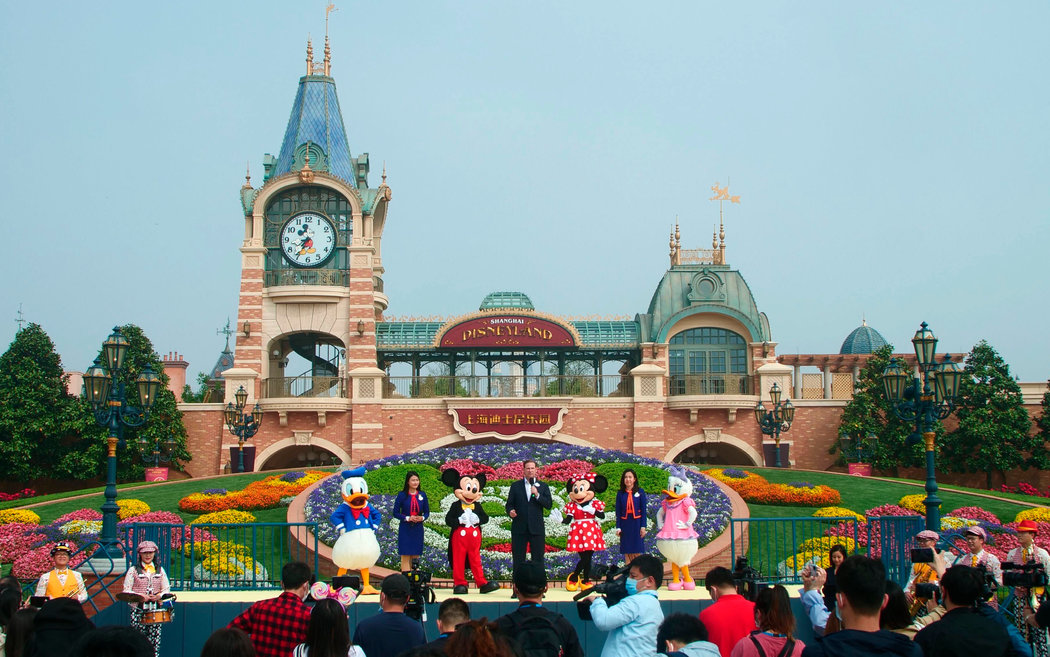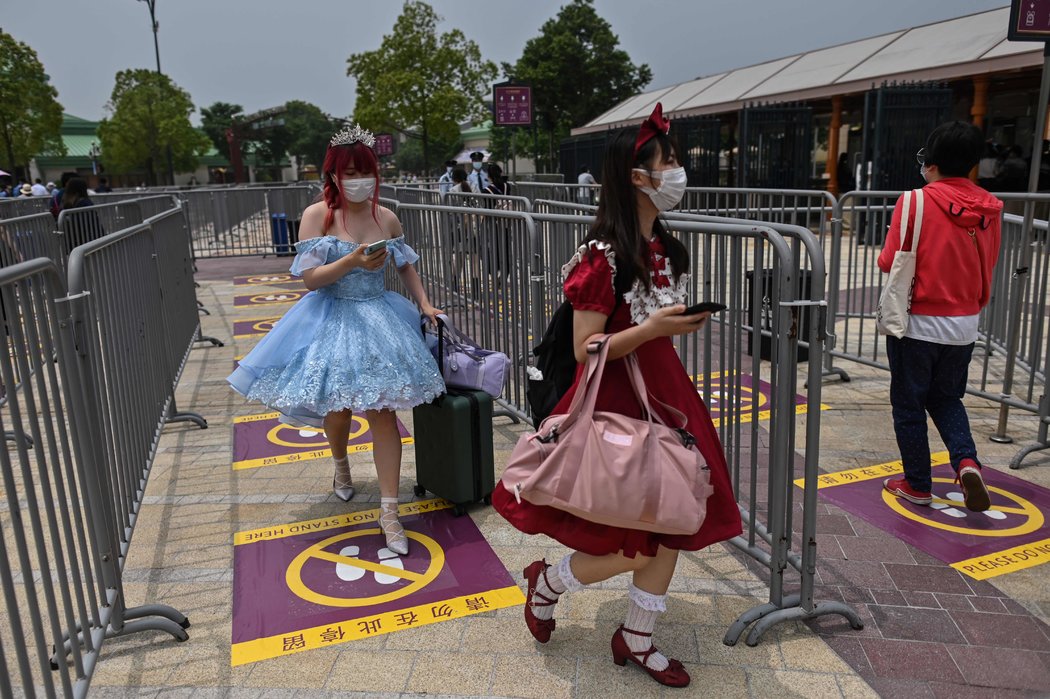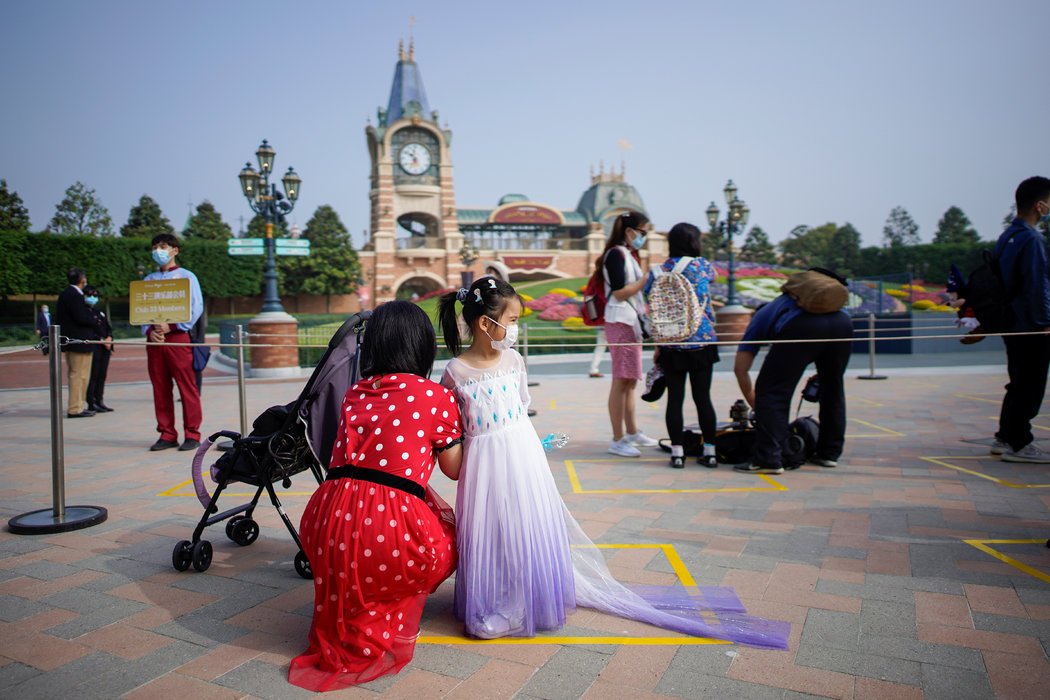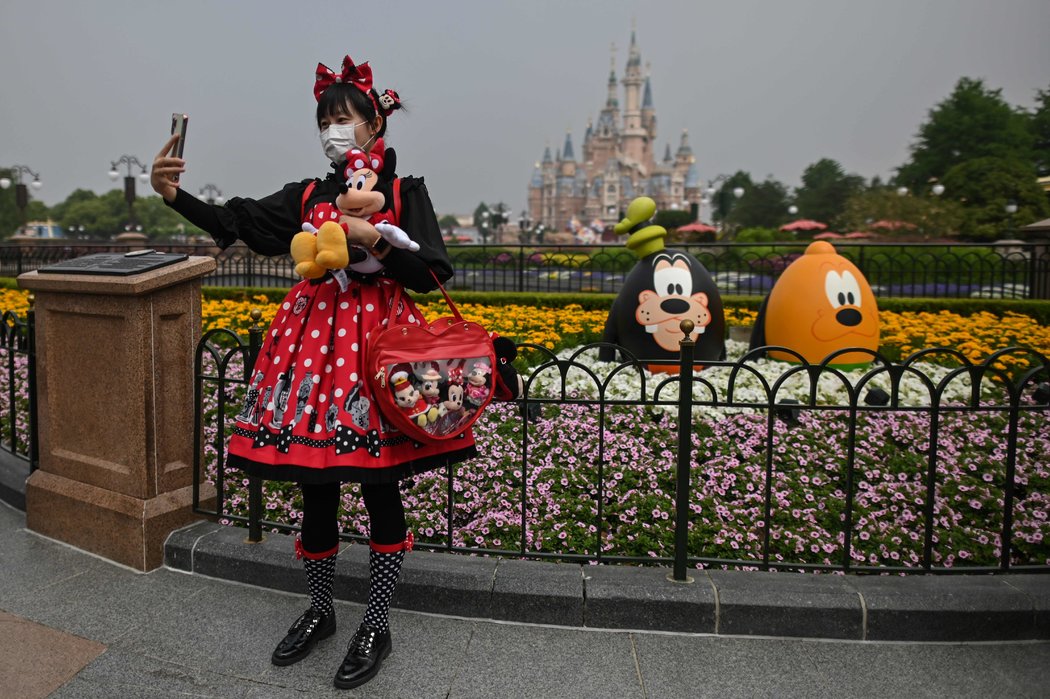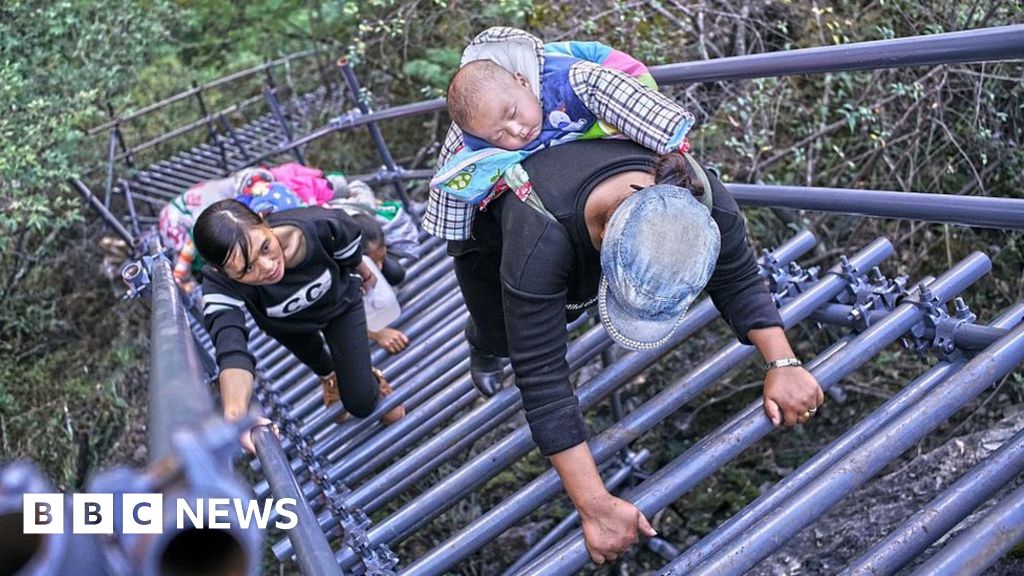上海迪士尼乐园周一重新向游客开放。尽管实施了严格的限流措施,园内的游览规定和开放项目也出于安全考虑做出了调整,但重新开园的决定仍然向世界发出了积极的信号。

cn.nytimes.com
Shanghai Disneyland Reopens With Strict Safety Procedures
BROOKS BARNES2020年5月11日
周一,穿着角色服装的演员们在上海迪士尼乐园重新开园庆典上。这是迪士尼度假区中第一个恢复运营的乐园。 SAM MCNEIL/ASSOCIATED PRESS
Sign up for NYT Chinese-language Morning Briefing.
(欢迎点击此处订阅NYT简报,我们将在每个工作日发送最新内容至您的邮箱。)
The elephants are flying again.
小飞象又飞起来了。
On Monday, one of the Walt Disney Company’s 14 closed theme parks,
Shanghai Disneyland, reopened to visitors on a limited basis, offering a first peek into the kind of escape Mickey Mouse can offer in the age of face masks, social distancing and disinfectants.
周一,华特迪士尼公司(The Walt Disney Company)14个被关闭的主题公园之一——
上海迪士尼乐园向游客限流重新开放,让人们首次窥探到了米老鼠在口罩、社交距离和消毒剂时代所能提供的那种逃离感。
“It has been an emotional morning,” Joe Schott, president and general manager of the Shanghai Disney Resort, said in a phone interview. “There is light at the end of the tunnel.”
“这是一个激动人心的早晨,”上海迪士尼度假区(Shanghai Disney Resort)总裁兼总经理乔·肖特(Joe Schott)在接受电话采访时说。“隧道的尽头有曙光。”
From a business standpoint, Shanghai Disneyland will be operating far below its potential. The Chinese government has limited capacity at the park to 24,000 people daily, less than one-third of its pre-outbreak capacity.
Bob Chapek, Disney’s chief executive, said last week that Disney would reduce ticket sales even further — “far below” the government’s limit, in his words — to make sure that employees can enforce new safety rules, including temperature checks for ticket holders upon arrival. Fewer tickets sold means decreased food and merchandise sales.
从商业角度来看,上海迪士尼乐园的经营将远低于其能力范围。中国政府已将乐园的日接待量限制在2.4万人,不到病毒暴发前的三分之一。迪士尼首席执行官
鲍勃·查普克(Bob Chapek)上周表示,迪士尼将进一步减少门票销售量——用他的话说,“远远低于”政府的限制——以确保员工能够执行新的安全规定,包括在持票人抵达时进行体温检查。门票销售量减少意味着食品和商品销售量也将减少。
中国政府将乐园接待客人数量限制在每天2.4万人以内。 HECTOR RETAMAL/AGENCE FRANCE-PRESSE — GETTY IMAGES
Yet the reopening carried immense symbolic importance. It sent a message to Disney’s furloughed park employees —
43,000 in Florida alone — about the future: There will be one.
然而,重新开园具有巨大的象征意义。它向那些被休假的迪士尼员工的未来发出了一个信号。仅在佛罗里达州,就有
4.3万名迪士尼员工被休假。
Investors have been relieved. Disney shares have climbed 8 percent since May 5, when
Mr. Chapek announced that Shanghai Disneyland would reopen, perhaps paving the way for similar actions at Disney resorts in the United States, Japan and France. The limited number of tickets that Shanghai Disneyland put on sale for this week
sold out within hours, suggesting that people are willing to resume public activities, even without a vaccine.
投资者们纷纷松了一口气。自5月5日
查普克先生宣布上海迪士尼乐园将重新开放以来,迪士尼的股价已经攀升了8%。上海迪士尼的重新开放或许将为美国、日本和法国的迪士尼度假区的类似行动铺平道路。上海迪士尼乐园本周限量发售的门票在
数小时内就已售罄,这表明即使没有疫苗,人们也愿意恢复公众活动。
Time will test the ability of Disney’s theme parks to program out negative aspects of life and emphasize the positive.
时间将考验迪士尼的主题公园是否有能力应对生活中的消极面,并突出积极的一面 。
When the Shanghai resort reopened on Monday, according to videos of the event, cast members — Disney’s term for employees — lined Mickey Avenue, which leads to the castle and aerial Dumbo ride, and waved madly as they greeted attendees. Belle, Minnie, Woody,
Duffy and other costumed characters appeared with welcome banners as a marching band played an upbeat “Mary Poppins” tune.
活动视频显示,周一上海度假区重新开业时,演员(这是迪士尼对员工的称呼)在通往城堡和小飞象(Dumbo ride)的米奇大道(Mickey Avenue)上排成一排,疯狂地挥手,向来宾们打招呼。贝儿(Belle),米妮(Minnie),伍迪(Woody),
达菲(Duffy)和其他角色们打着欢迎横幅出现在活动现场,乐队演奏着欢快的“玛丽·波平斯(Mary Poppins)”曲调。
园区内的游客被要求戴上口罩,并在地面上用胶带做了标记,以保证社交距离。 ALY SONG/REUTERS
“Life can get you down,” Mr. Schott said. “Our brand is about hope.”
"生活会让你沮丧,"肖特说。"我们的品牌是关于希望的。"
To safely reopen, however, Shanghai Disneyland had to allow some of the grimness of pandemic life to puncture the utopian fantasy. All guests and park employees must wear face masks. Costumed characters are the only exception, and they now pose for photos from afar. The park is dotted with garbage cans dedicated solely to used face masks.
然而,为了安全地重新开园,上海迪士尼乐园不得不让一些在病毒大流行下生活的严峻性刺破乌托邦式的幻想。所有游客和乐园员工都必须戴上口罩。盛装角色是唯一的例外,他们现在只能在远处摆出姿势拍照。公园里到处都是专门用来存放用过的口罩的垃圾桶。
Parades have been suspended because people crowd sidewalks to watch them. Theater shows also remain closed. For now, Shanghai Disneyland will offer an evening castle show but no fireworks. To discourage people from bunching up in line as they wait for rides, Disney has placed purple social-distancing mats on the ground.
巡游表演已被暂停,以防止人们挤在人行道上观看。剧院表演也尚未开放。现阶段,上海迪士尼乐园将提供一个晚间城堡表演项目,但不燃放烟花。为了阻止人们在等待乘坐娱乐项目时聚集在一起,园区在地面上放置了紫色的保持社交距离地垫。
一位游客实践着保持社交距离的规定。 HECTOR RETAMAL/AGENCE FRANCE-PRESSE — GETTY IMAGES
“So far, guests are being very, very respectful about social distancing,” Mr. Schott said.
“到目前为止,游客们对保持社交距离非常、非常尊重,”肖特说。
To ward off germs, Disney has decided to leave rows of seats empty on rides like Pirates of the Caribbean. Employees have been deployed to constantly disinfect ride vehicles and lap bars. Want to hop on
Buzz Lightyear’s Planet Rescue, where riders zap targets with hand-held blasters? You now must wear plastic gloves.
为了抑制细菌,迪士尼已决定在“加勒比海盗(Pirates of the Caribbean)”之类的游乐设施中设置隔排空位。员工不断为游乐设施游乐和座位上的扶杆消毒。想乘坐“巴斯光年星际营救(
Buzz Lightyear’s Planet Rescue)”,手持爆破装置击中目标?现在,您必须戴上塑料手套。
The Shanghai Disney Resort began to reopen in early March. First, an adjacent shopping mall, Disneytown, resumed operations. Lego, Build-A-Bear, Swatch, Nike and Starbucks have stores there. Two other areas of the resort, a lakeside area called Wishing Star Park and the upscale Shanghai Disneyland Hotel, also gradually reopened before the theme park itself.
上海迪士尼度假区于3月初开始重新开放。首先恢复营业的是邻近的迪士尼乐园购物中心。乐高(Lego),“熊熊工作室”(Build-A-Bear),斯沃琪(Swatch)、耐克(Nike)和星巴克(Starbucks)在这里均设有店面。度假村的其他两个区域——被称为星愿公园的湖边区域和高档的上海迪士尼乐园酒店,也在主题公园本身开放之前即逐步重新开放。
Disney owns 43 percent of the $5 billion resort, with the majority stake held by a Chinese state-controlled consortium. Disney owns 70 percent of the management company that operates the property.
迪士尼拥有这个价值50亿美元的度假区43%的股份,度假区的多数股权由中国国有集团持有。迪士尼拥有经营该物业的管理公司70%的股份。
Shanghai Disneyland attracted roughly 12 million visitors last year, an 8 percent increase from 2017, its first full year of operation, according to the Themed Entertainment Association. To compare, Disney’s No. 1 park, the Magic Kingdom at Disney World in Florida, had about 21 million visitors last year. The
troubled Hong Kong Disneyland had attendance of 6.5 million.
根据主题娱乐协会(Themed Entertainment Association)的数据,去年,上海迪士尼乐园吸引了约1200万游客,比2017年(其首个完整运营年份)增长了8%。相比之下,迪士尼的第一家公园——佛罗里达州迪士尼世界之魔法王国(Magic Kingdom at Disney World),去年共接待了2100万游客。陷入困境的香港迪士尼乐园的年游客量为650万。
It is unclear when Disney’s other theme parks may start to reopen. But Disney has signaled that its vast resort in Florida could be next. The shopping mall there, Disney Springs, will begin phased reopening on May 20.
目前尚不清楚迪士尼的其他主题公园何时会重新开放。但迪士尼已暗示其位于佛罗里达州的大型度假区可能是下一个。那里的购物中心迪士尼温泉(Disney Springs)将于5月20日开始分阶段重新开放。


